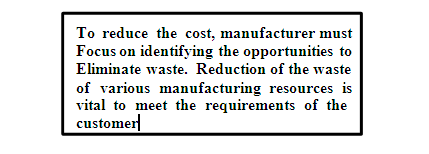
In an industry, waste occurs at every stage of manufacturing and therefore a need is left for waste reduction and to know the reasons behind the occurrence of these wastes. This paper discusses the basic concepts, regarding waste along with the ways and means to eliminate it. A case study of a large boiler manufacturing unit is also presented, illustrating the methodology for identification and quantification of the waste, along with a solution to reduce the waste, so identified
Today’s dynamic market situation is customer driven. Customers decide the fate of any manufacturer in the market. Thus customer oriented manufacturing is essential in order to survive and grow in the market. Customers need products of good quality, at lowest possible cost, with minimum lead-time. The rising industrial competitiveness is based on this need of the customer. In order to meet this requirement of the customers, every manufacturer has to reduce the cost of a product without compromising its quality. Cutting down manufacturing lead-time is essential in order to meet market requirements. To reduce the cost, manufacturer must focus on identifying the opportunities to eliminate waste. In other words, reduction of the waste of various manufacturing resources is vital to meet the requirements of the customer.

What is waste?
Every manufacturing organisation consumes some resource(s) other. For manufacturing any product whatever be the resources ideally required, never matches with the actual consumption of these resources. It always consumes more than what is ideally required.
Thus generation of waste, in one or other form, is inevitable in the functioning of any manufacturing organisation. Resources, such as money, manpower material time, space, which are ideally used is the essential requirement of manufacturing. Anything in excess of this is a waste. Thus waste has been defined as unnecessary input of any of the manufacturing resources. In other words, anything required beyond the bare minimum, to manufacture a product, is a waste.
Types of Waste
Waste can be classified in a variety of ways, depending upon the basis of classification. There could thus be four bases for classification.
Limiting our scope to the first category, i.e. waste of all resources, we can identify various wastes as shown in fig.1. Some of the basic forms in which waste of these resources may occur are as, below
Of the above forms, waiting time is one of the most important, resulting in the waste of time, which can be measured in terms of the hours required in excess of the budgeted hours.
In any manufacturing situation, a number of hours are wasted because of unnecessary transport of job and for unwanted movements of workers. Excess inventory results in the waste of money, as money gets blocked during the period inventory is held. In the salvaging of defectives a lot of hours are required for reworking, resulting in waste of time. Overproduction; locks valuable shop floor. Unnecessary processing adds to waste of time and material.
There are no specific reasons for the occurrence of waste. The reasons for waste vary from industry to industry. They may be avoidable or unavoidable improper planning, lack of coordination in manufacturing, absence of proper system to identify and prevent the occurrence of waste, technological limitations, etc. all result in waste.
Waiting time occurs if all the resources required for manufacturing are not available as and when required. Improper shop layout and poor housekeeping causes unnecessary movements to workers on shop floor resulting in waste of valuable man-hours.
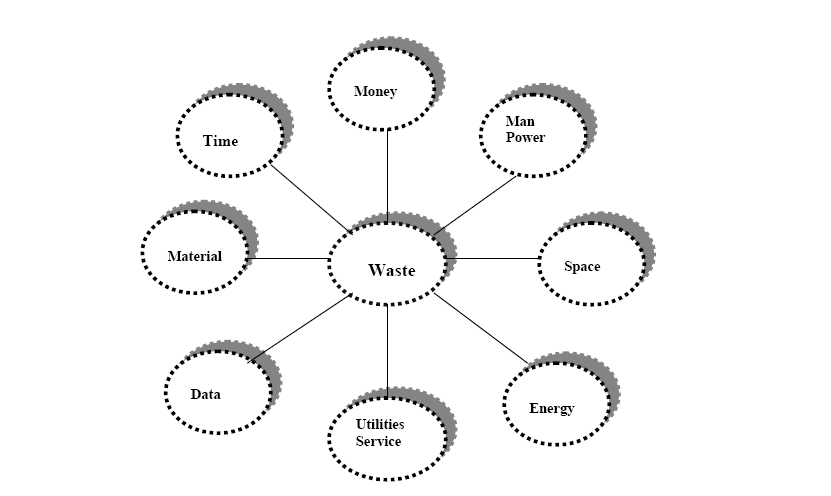
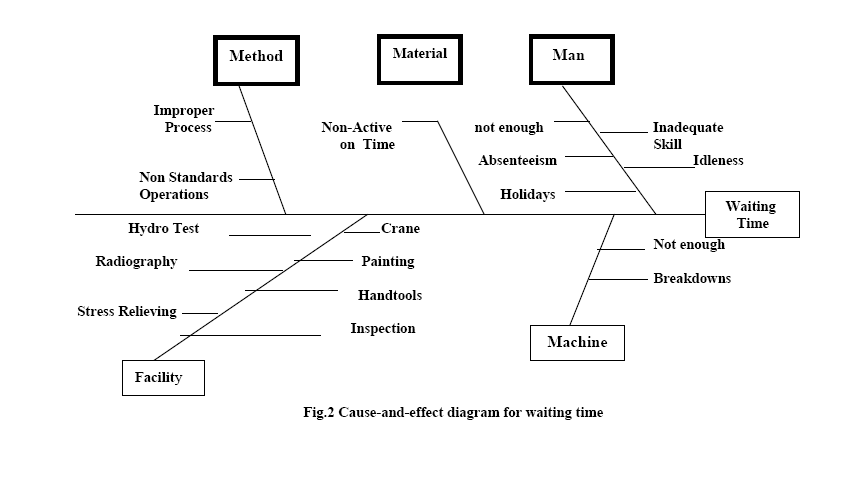
Excess inventories are maintained to have a very high degree of service level to avoid shortages and to avail of favourable low prices of material and quantity discount. But many a time, this is done without economic evaluation, resulting in increase of overheads.
Overproductions to meet rush orders of customers, improper forecasting or overestimation of market situation create lot of waste
Defectives, which include rejects and rework, form a major waste industry. It may be due to various controllable or uncontrollable factors: such as improper methods and tooling, inadequate skill of the worker. But all these result in a low quality product.
Sometimes specifications, which may not be functionally relevant and/or important, are laid upon a product entailing needlessly accurate processing method which increase manufacturing cycle time and creates the waste.
Thus, it can be summarized that in industry waste occurs not because of any one reason in particular but owing to a combination of various factors.
The ways of waste elimination vary with the Industry and depending upon the form of waste and the conditions peculiar to the situation. However, some of the generalized ways for waste elimination are discussed below.
Method study application identifies the unwanted activities and movements of the job and worker, thus passing the way to standardize the operations along with modifications in existing layout to improve the shop environment. Various material control systems like MRP-1. MRP-II, etc., can be used for keeping the inventory level at optimum. Rejects and rework can be reduced by standardizing the operations. Advanced production technology can be used to improve the quality of products, minimizing rejects and rework. Implementation workers supplemented by their adequate training as necessary, will also help in this direction. As far as possible workers should be multi-skilled.
Overproduction, necessitating a huge inventory, can be eliminated by forecasting the market demand with greater accuracy and a high confidence level. Production level, should be regulate on the basis of continuous feedback from the market. Overproduction, necessitating a huge inventory, can be eliminated by forecasting the market demand with greater accuracy and a high confidence level. Production level, should be regulate on the basis of continuous feedback from the market.
Overproduction, necessitating a huge inventory, can be eliminated by forecasting the market demand with greater accuracy and a high confidence level. Production level, should be regulate on the basis of continuous feedback from the market.

Waiting time, being one of the most important forms of waste, can be ascertained by locating the areas where waiting occurs and then critically analyzing the causes contributing to waiting time.
The above discussion would prove that waste of time is critical, because time is a resource which can not be created or manufactured. So it should be utilised most judiciously.
In a large boiler manufacturing plant, analysis of past data revealed that actual. Throughput time (TPT) was for higher than budgeted. It was also found that the level of rejects and rework was almost negligible. Observations indicated that jobs remained idle on the shop floor most of time for want of some or other resources, thus increasing the TPT. A detailed study was then carried out to quantify the waiting time and remedies suggested for its elimination.
For quantifying the waiting time, different causes were first identified by drawing a cause and effect diagram as shown in fig.2.
Then to determine the contribution of each cause to the waiting time. Work sampling technique was selected as the best and most appropriate. Each unit on the shop floor was considered a subject for observation. Assuming 95 per cent confidence level and a 95 per cent accuracy, total number of observations were computed random observations were made at different time points chosen using random number table. During each round, jobs on the shop floor were observed for working or non-working state. Simultaneously the reasons for non working state were found out and a code assigned to each reason.
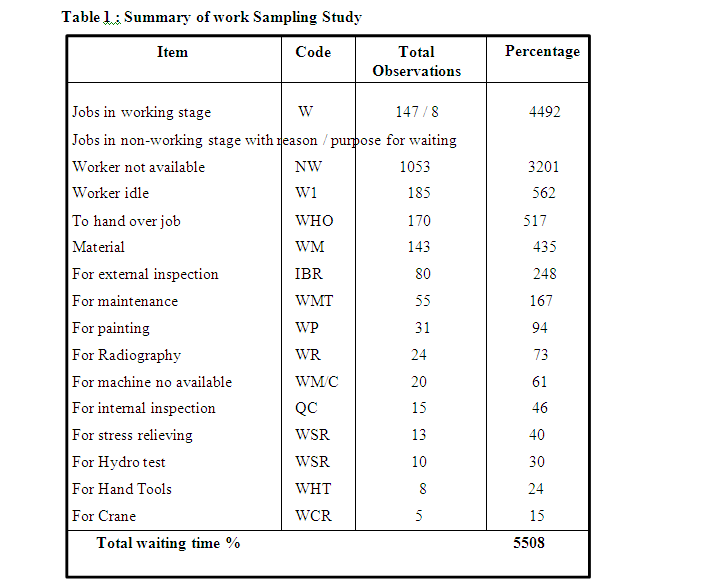
The summary of work sampling study along with various reasons for non-working state with their respective code is given in table.
Pareto analysis of the total waiting time was done and the results are depicted in fig.3. It can be seen therefrom that for a major portion of the duration no manpower’ condition existing in the shop resulting in high waiting time. Analysis of availability of manpower on the shop floor indicated that a certain number of jobs could only be processed by the available manpower. Whenever the number of jobs on the shop exceeds this limit, extra manpower is needed, which the company can not provide and hence no worker condition existed most of the time. This indicates that high work-in progress level is the basic reason for existence of no-worker condition. This creates a need to adjust WIP level to the existing manpower.
Thus snags in the shop are
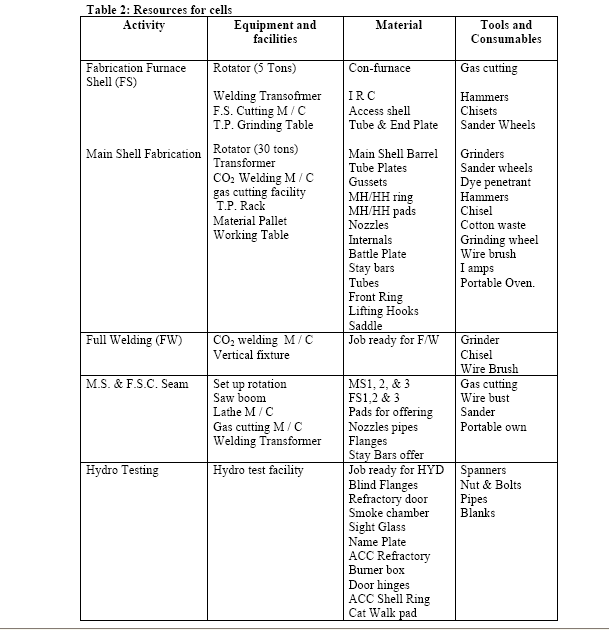
It is known that arrangement of shop floor in cellular form, in which related activities are carried out in one cell, has various advantages. It affords visual control of the activities are carried out in one cell, has various advantages. It affords visual control of the activities, and v makes accountability and adherence to the schedule possible. Cellular manufacturing arrangement also reduces unnecessary movement of job, which in turn improves quality and gives an efficient material handling arrangement. Reduction in setup and downtime can be possible with this arrangement. Operator as well as supervisory staff utilization gets increased. All these features of cellular manufacturing arrangements reduce manufacturing cycle time resulting on low WIP level.
In cellular manufacturing arrangement, all resources, such as machine tools, material handling equipment and such the auxiliary facilities required for producing a particular part/component an grouped together and made available at one place.
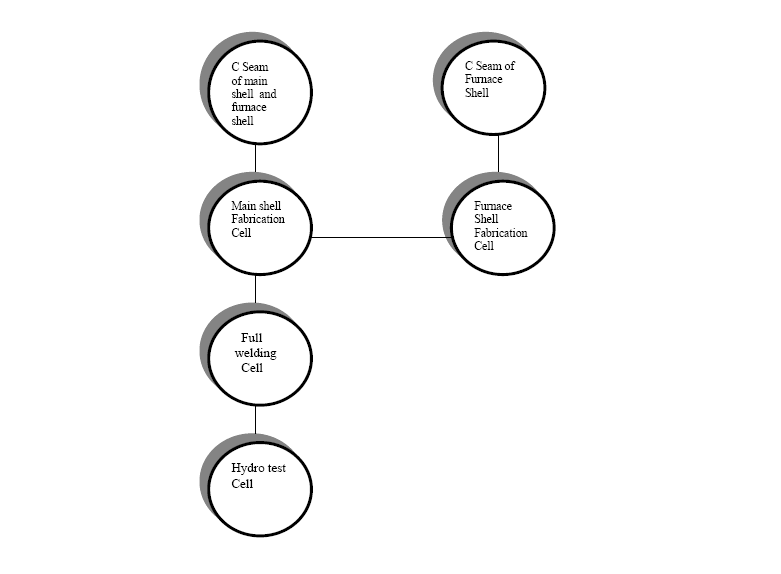

Thus it was concluded that cellular manufacturing arrangement is the best suitable for eliminating the existing problems in the system. The action plan for creating such an arrangement consists of the following stages:
Identification of cells. To identify the different cells, activities required to manufacture the product were first listed. The related activities were when so grouped that each cell should be able to produce an identification output. Thus in our case five kinds of cells were identified as shown in fig.4.
Interdependence of the cells is depicted in fig.5
Resources for each cell. Resources, such as material, machine, tools and facilities required for each cell were identified as given in table 2.
Arrangement of cells:The space required for each cell was first estimated by considering the space need for various resources as well as the working space, etc. Then the number of cells of each category was decided by taking into account the available shop-floor-space and TPT of each cell. Cells having less TPT were kept fewer in number as compared to those with high TPT to maintain the interdependence between the cells. This reduces the in-process waiting time.
Information system for each cell. To monitor the progress of each cell a display board was prepared recording the details of material required on a particular day, analysis of the TPT of that cell etc. This was also helpful to determine the exact status of any job on the shop-floor.

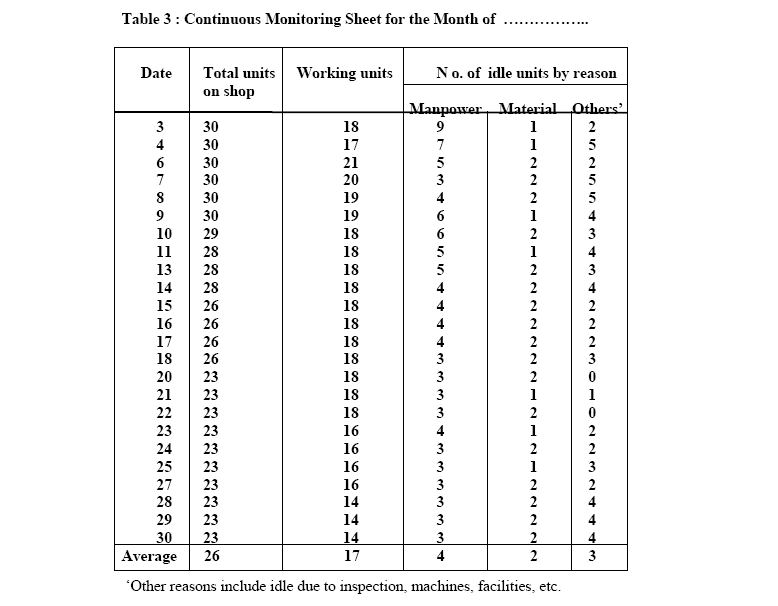
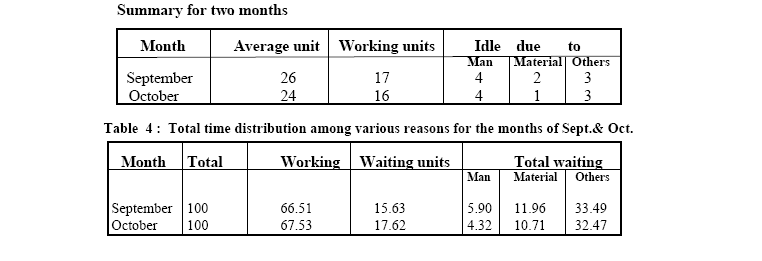
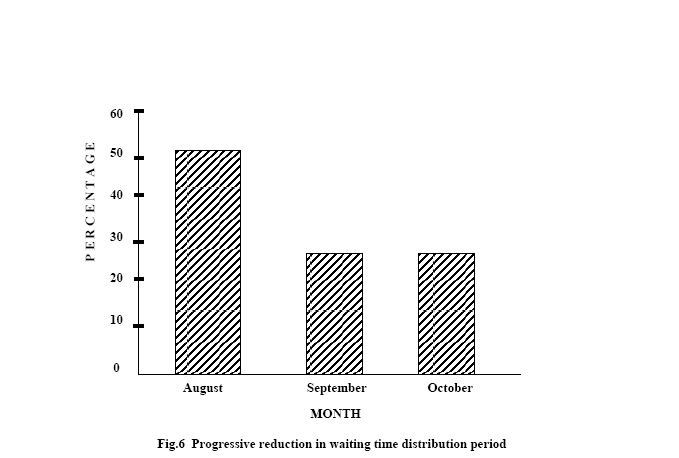
Recording the details of material required on a particular day, analysis of the TPT of that cell, etc. This was also helpful to determine the exact status of any job on the shop floor.
Scheduling of each cell – for a perfect planning of the activities performed in a cell, schedule for each cell was individually prepared instead of a total schedule for the job. This helped in determining the exact dates of material requirement along with the inspection dates, etc. Project Management packages like PRISM can be used for scheduling of the activities.
Continuous monitoring of the cells. The whole shop floor was monitored of the cells. The whole shop floor was monitored each day to found out the progress of each cell using a monitoring sheet (see table 3). In addition, it informs about the non-working cells and reasons for idleness. Average WIP level during a particular month and details of working and non-working of the job can be calculated from the data collected.
Data collected as above from continuous monitoring can also be used to calculate the waiting time during the month. Waiting time for various months is given in table 4. It was found that waiting time reduced to 33.49 per cent from 55.08 per cent. The progressive reduction over the two months is shown in fig.6. Reduction in waiting time directly reduces the TPT of the product, which, in turn, cuts down the manufacturing lead-time.
This demonstrates the success of this arrangement in reducing waiting time and fulfilling of the objective. Hence cellular manufacturing arrangements in one of the best ways to reduce waiting time of the product and eliminate delays.
Granting that some amount of waste inevitable in any manufacturing organisation and it can not totally eliminated, substantail reduction is still possible through a structured approach in identifying the wastes followed by steps to minimize them. In this regard cellular manufacturing arrangement is eminently useful. Indeed, reduction of waste occurring in manufacture greatly helps improve an organisation’s productivity without calling for substantial additional resources.